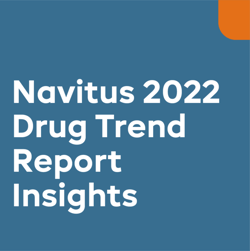Our pharmacists are always monitoring the drug development pipeline to help plan sponsors stay ahead of the curve on new and upcoming medications. Learn about the most important upcoming non-specialty drugs of 2022, including new treatments for COVID-19.

Because non-specialty drugs only represent around 20% of new drug approvals, they often take a back seat in conversations about upcoming drugs. However, they continue to have an important role for members and plan sponsors alike, with non-specialty spending making up around 50% of all medication spending in the United States. While they tend to cost less than specialty medications, non-specialty drugs can have an outsized impact given the number of patients they treat.
If you would like to learn more about what it takes to develop a drug and bring it to market, be sure to check out our previous article here.
Covid-19
Unsurprisingly, the non-specialty category that has received the most attention over the last 18 months is COVID-19 therapeutics. While vaccines were the major focus of 2020 and 2021, and will continue to be of great importance in 2022, expect a greater focus on treatments and post-exposure prophylactics (preventative treatments given after an exposure to limit infection) next year. Several oral antiviral products are expected to be authorized in the coming months.
- The oral antiviral molnupiravir could receive Emergency Use Authorization (EUA) from the US Food and Drug Administration (FDA) as early as December for treating adult outpatients with COVID-19 who are at high risk of developing a severe form of the disease. It is also being investigated for use in post-exposure prophylaxis, where it would be given to healthy household contacts of people who test positive for COVID-19. That trial is anticipated to conclude in April of 2022.
- Paxlovid™ (PF-07321332/ritonavir) is another oral antiviral that has been submitted to the FDA for EUA, with a possible decision in December 2021. As with molnupiravir, studies for its use in post-exposure prophylaxis are ongoing and expected to conclude in March. Additionally, there is an ongoing study involving outpatient adults with COVID-19 who are not at high risk of developing severe disease.
- In addition to these novel oral antivirals, Regen-Cov (casirivimab/imdevimab) is a combination monoclonal antibody treatment that was previously approved through EUA for treatment and post-exposure prophylaxis. It is under priority review by the FDA, with a decision for full approval expected by April 13, 2022.
Beyond COVID-19, we are watching the development of several antiretrovirals for treating or preventing HIV.
- Approved for treating HIV earlier this year, Cabenuva (cabotegravir/rilpivirine) is under priority review for use in pre-exposure HIV prophylaxis. If approved, Cabenuva would be the first long-acting injectable used to prevent HIV, with head-to-head data showing its superiority over the current market leader, emtricitabine/tenofovir disoproxil fumarate. A priority review decision is expected on January 24.
- Another long-acting injectable, lenacapavir, is awaiting a priority review decision on February 28, 2022. Lenacapavir works via a novel mechanism as a capsid inhibitor, and would be the longest-duration HIV injectable available, with injections every 6 months. It is intended for use as an add-on for highly treatment-experienced patients with multi-drug resistant HIV.
- An additional new HIV treatment option is islatravir, an oral non-nucleoside reverse transcriptase traslocation inhibitor. Merck is expected to apply for the approval of a two-drug combination with doravirine, which could be approved by late 2022 for the treatment of HIV. Longer term, this agent is also in trials for pre-exposure prophylaxis and in combination with the aforementioned lenacapavir.
- Lastly, leronlimab is a weekly subcutaneously injected CCR5 antagonist, commonly referred to as an “entry inhibitor,” which prevents HIV from entering and infecting immune cells. Trials have supported its use as an add-on for highly treatment-experienced patients with multi-drug resistance. An application for approval is expected to be finalized in Q1 2022, with potential approval in late 2022 or early 2023.
Anemia
Three agents representing a novel treatment class, hypoxia-inducible factor inhibitors, are in the near-term pipeline. These medications, all orally administered, are being studied for treating patients with anemia due to chronic kidney disease, including both dialysis-dependent and dialysis-independent patients. These products would compete with injectable erythropoiesis-stimulating agents such as epoetin alfa and darbepoetin alfa.
- Vadadustat may be the first product to be approved, with an FDA decision date of March 29, 2022, although approval may be limited to dialysis-dependent patients.
- A second agent, daprodustat, is expected to file in early 2022 for a 2023 approval, which could make it the first to be approved for both dialysis-dependent and independent patients.
- A third agent, roxadustat, was initially denied by the FDA in August 2021. An additional clinical trial will be required for resubmission.
new topical treatments
While specialty drugs for treating plaque psoriasis and atopic dermatitis are receiving significant attention, the following non-specialty topical treatments are also important to watch.
- Tapinarof is a once-daily topical cream that works via a unique mechanism, as a therapeutic aryl hydrocarbon receptor-modulating agent (TAMA). Studies have shown effectiveness in treating mild, moderate and severe plaque psoriasis in adults, and the FDA is expected to make a decision in Q2 2022. Tapinarof is also being investigated for use in treating atopic dermatitis, although studies are not expected to conclude until 2023.
- Roflumilast is a once-daily topical PDE-4 inhibitor under investigation for treating atopic dermatitis and plaque psoriasis of all severities. It is most likely to be approved for treating plaque psoriasis first, with an FDA decision in August 2022. Data supporting its use for atopic dermatitis are expected in late 2022, with potential approval coming later.
Staying ahead of significant new drugs can help reduce their impact on your organization’s drug spend and improve your members’ heath. Be sure to watch for our article on upcoming specialty medications next week.




